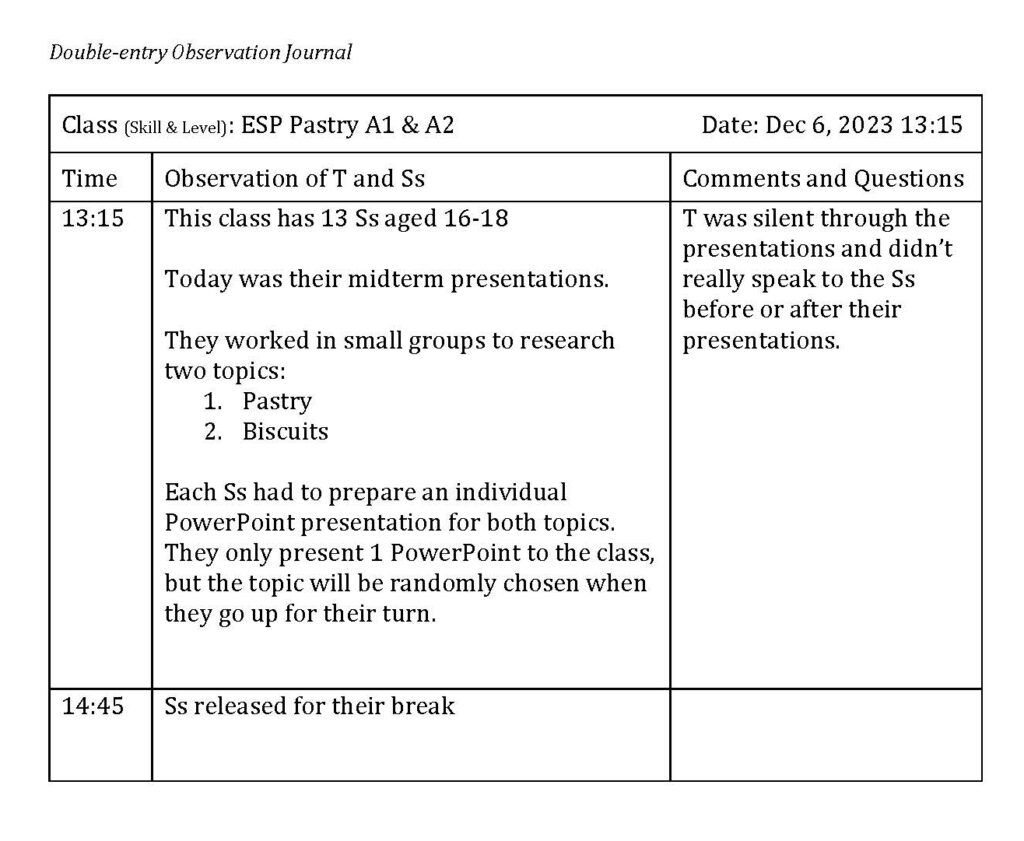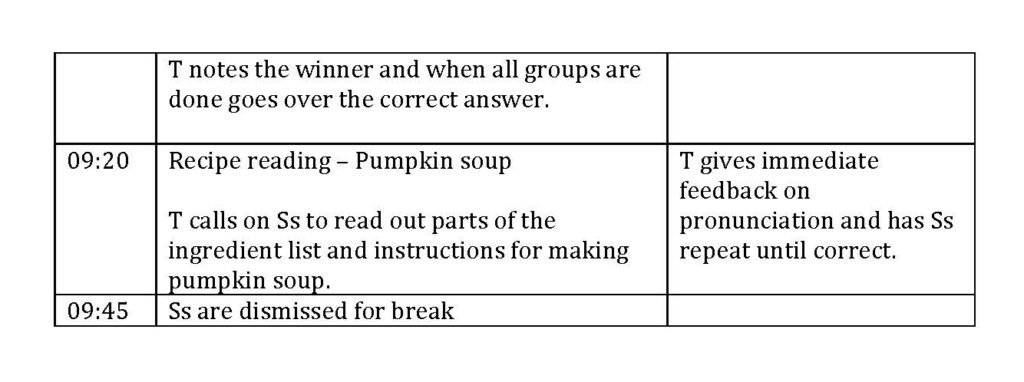

Reflection
I really looked forward to this class for the chance to observe the pedagogical approach to culinary ESP. The lesson in this class was to introduce a recipe. The vocabulary was vegetables. The part of class I observed was dedicated to reviewing and pronunciation of vocabulary and reading the recipe. I believe that there were some writing activities in the textbook as well that may have happened after I was dismissed. It seemed at this point in the curriculum, this was a common lesson format.
The teacher took the students through the vocabulary list numerous times, but each time, it was a step more difficult. At the beginning, each vegetable picture had its name displayed underneath. The teacher took the students through the list repeating after her, then together, then just the students, then randomized, all with the names displayed, finally randomized, and selecting individual students to say/read the vegetable name. She then repeated the process without the names displayed.
She then followed with the two small group activities. One was a match the picture with its label activity and the other was a reorder the steps activity. The final activity before the break was going over the pumpkin soup recipe, both the ingredients and the instructions. The teacher discussed with the students each step asking if they remembered the meaning of the instructions.
Watching and listening to the vocabulary repetition reminded me of my own experience in learning kanji in Japan. Each class, our teacher would use large, handheld flash cards and do much the same process. For me, personally, flashcard repetition has never been an effective study method because I can’t keep it up. Creating the flashcards, and then flipping through them one at a time doesn’t give me a sense of accomplishment. For memorizing vocabulary and kanji, I made lists by chapter and I would write out one to three lists worth each day. Usually, 1 for review, the 1 we were on and the one we would be looking at next. My aim was speed and understanding. I would do this before doing my homework, so that I was more successful at the exercises in reading and writing.
In a sense, I was priming my mind with all the vocabulary and kanji I needed to complete the homework, then I completed the homework quickly and efficiently, with a mind that was focused and relaxed. In the STHC class, there was rote memorization followed by a single activity that reinforced the repetition, but then the vocabulary was not really used in the 45-50 minutes until the first half of the class and the break ended. The new vegetable words were not in the recipe, but they were probably used in the textbook exercises in the second half of the class.
I thought it was an interesting idea to have one activity for the vocabulary, and one for the recipe, but I might have spaced them differently. This is the order I would have used to keep the students engaged:
- Introduce the vocabulary, doing the first round of repetition, and check pronunciation.
- Then a Kahoot game where the students had to guess the vegetable from a description of its properties. The descriptions could be in both Vietnamese and English, with the answers only in English.
- Then the activity to match the picture with the label
- Then the large group quick review of the vegetables without the labels (this would be optional based on time)
- Then the activity to reorder the recipe steps as review
- Have the students read the recipe in their small groups for 5-7 minutes and come back to the large group and do a 3–4-minute review and answer any questions.
- Have the students look for a recipe online, or write one they know, that uses at least 2 or 3 of the vegetables from the list. They would need to write as much as they could in English and then collaborate with their small group to see if they could fill out their English recipe.
The students are in class for more than 3-hour blocks with only 1 break. It is a long study period. Changing the type of activity regularly and size of group they work in, allows the students mind to keep moving and stay more engaged and alert. It is even better to plan periods of physical activity (TPR), and use realia to allow the students to connect to the material in as many ways as possible.
In speaking with the students, I realized that they were learning food vocabulary, cooking technique vocabulary, but when I asked them if they were learning to be a cook or a chef, they got confused and said no. They are learning food but not who they are as they interact with the food, and how they might need to interact with the public, even though they work in the kitchen. Perhaps they will need to answer a room service call, or when setting out a dish on a buffet, a guest might ask about the dish, or even something as simple as answering a question about needing eating utensils, or the location of the bathroom. I am very interested in the overall curriculum of an entire program. Is there any intercultural communication training at the higher levels, or information about language differences between English dialects. These students have undertaken English to make themselves more valuable on the job market, but they don’t need to just memorize set phrases, they need to be able and willing to communicate in English. In Peter MacIntyre’s theory on willingness to communicate, he has found that the two main supports for that willingness is a low level of situational anxiety, and confidence in self-perceived ability. There are many other factors involved, but these are the main two. My interest in curriculum development is to see how the concept of willingness to communicate, intercultural communication and a multilingual identity can be fostered at the higher level.